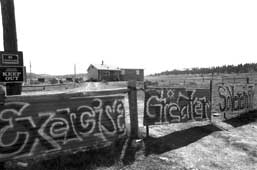|
|
||
|
Cheyenne want
prosperity, Jobs are scarce
on the Northern Cheyenne Reservation. Story by Courtney
Lowery
The winds whipping off the hills near the western border of the Northern Cheyenne Reservation make the nights a little chilly, even in the spring. So when the sun goes down, C. Robert Yellow Fox and Evone Spang pull their mattress into the living room to be closer to the wood stove. It’s hard to get ready for the night after it has already come, so the couple pulls up the garbage bag shades and prepares while the sun is still letting a little light through their living room windows. Spang pulls the cushions off the couch and lines them up against the walls of the small room for makeshift insulation, and Yellow Fox grips his hatchet to make kindling of the pile of wood in the corner. Yellow Fox and Spang have been without electricity for more than a month, and don’t expect to get their power back for another two weeks. They just don’t have the money to pay the bill. It’s been more than a year since either of them has had a job. “We’ve both got our resumes, but there just aren’t any jobs for us,” Yellow Fox says. Yellow Fox, 26, went to the 12th grade at Colstrip High, but dropped out just a semester shy of graduation. He is tall and tough, his hands calloused and worked. It’s easy to see his hands have been well used since high school, making money while he drifted from one temporary hard labor position to another. Spang, 28, is shy and articulate, her gentle voice sometimes lost under Yellow Fox’s robust one. She has a two-year degree from Dull Knife Memorial College in Lame Deer. But her degree doesn’t mean much in an area where job opportunities are scarce. “This is the Third World of America,” Yellow Fox says. The Northern Cheyenne Reservation’s unemployment rate fluctuates from 30 percent to as high as 65 percent on a recent count. Most tribal members who are employed work for the tribe, which employs 250 members full time. Indian Health Service, the Bureau of Indian Affairs and the tribe make up 41 percent of the available employment. The education system, including K-12 schools across the reservation and Dull Knife Memorial College together employ 48 percent. Others who have jobs find work as farmers, or ranchers or mill workers and a handful are employed at the few businesses on the reservation. The three main tribal enterprises, the Cheyenne Depot, the Charging Horse Casino and the Tongue River Mill, employ only 108 full-time workers-1.4 percent of the 7,808 total reservation population. Tough as it may be to make a living, neither Spang nor Yellow Fox will even entertain the thought of assistance.
“You mean like welfare and stuff?” Yellow Fox asks. “No. We won’t do that ... We shouldn’t have to.” Yellow Fox and Spang’s situation is not an uncommon one for Native Americans their age, and on the Northern Cheyenne, their generation makes up more than 20 percent of the population. Sixty-one percent of the population has a high school degree or above, yet the unemployment rate hovers around that same percentage. “We’re not the only ones out here going through this,” Yellow Fox says. “Just ask anyone our age on the street and they’ll tell you the same thing.” John Youngbear, 30, is one of those people. “Forever, they’ve been telling us, go to school, do something for yourselves so you can come back and do something for your tribe ... and then you come back and there is nothing here,” says Youngbear. Youngbear, after four years at the University of Montana and numerous photojournalism internships at some of the best newspapers in the country, has returned to the reservation. He came back to be closer to his family, closer to his home. He now revels in helping take care of his sister’s two little girls and knows his nieces feel lucky to have their Uncle John around. Once home, Youngbear quickly saw there were few jobs, so he created his own. He now runs a monthly magazine, Cheyenne Avenue, which focuses on Indian issues on the reservation. It is a heart-filled project for Youngbear, but one laden with obstacles. For lack of office space in town, Youngbear runs the production of the magazine out of his sister’s home, where he lives. It’s circulated free on the reservation and the magazine breaks even from the advertising it carries. He hopes it will soon turn a profit and spread to readers off the reservation. Just down the street, Michelle Summer uses the pay phone at the one gas station in town. Summer recently moved back to the reservation where she was born. As a child, she was taken from her mother and placed in a foster home in Bozeman. When she reached adulthood she lived in New Mexico, but after two years there made the decision to move herself and her three children to Lame Deer. “I wanted to get back to where my roots are,” she says. And she wanted to give her children what she was robbed of as a child. “I wanted my children to grow up in their culture.” She is working through the Welfare-to-Work office now, but hopes to find a permanent job soon. She doesn’t have a phone yet. “It’s hard to find a job. It’s really hard,” she says. The particulars of why Cheyennes like Youngbear and Spang come back or stay on the reservation vary, but the common thread is a yearning for their land and people. “This is where my family, my culture, my home is,” Spang says, looking toward the vast expanse that stretches uninterrupted for miles. “There’s no smog, there’s no traffic every five minutes, you can actually see the sky ... I wouldn’t change it for anything.” Spang could go off the reservation and find a good-paying job with her degree, she says. She’s often thought of leaving, but she’s not one to let money guide her choices. “No matter how much money you make, or what kind of car you drive... that stuff doesn’t matter if you don’t have your culture, your home,” she says. And so the task before those who direct economic development on the Northern Cheyenne Reservation, like many other reservations, is finding a balance so people like Spang can stay where her heart is and still survive financially. The tribe has set up enterprises, like the Cheyenne Depot and the Charging Horse Casino, but while they provide services to the community or bring in revenue for the tribe, they don’t employ in large numbers. The Tribal Employment Rights Office ensures that those actively looking for work within the tribe get first priority, but again, does little to expand the job base. As the tribe’s economic planner, Joe Little Coyote, puts it, they are striving to find an economic development plan that is most importantly, “culturally appropriate.” In early March, Little Coyote’s office made the first step toward finding a balanced economic plan that would maintain the values of the Northern Cheyenne people and still launch them into an evolving economic age. He began circulating a survey throughout the reservation to establish goals and priorities, not only those of the economic development office, but those of the members of the tribe, ones like Yellow Fox and Spang, who are living and breathing in the present desperate conditions. Thus far, simply the presence of the discussion, however informal, is essential, says Youngbear, who along with Little Coyote’s son, Eugene, and several other tribal members his age have formed the Junior Pathmakers, a tribally recognized advisory board of sorts. The group is at the forefront of the discussion, bridging the gap between the cultural aspirations of the elders and knowledge of the advances of the modern business world. “At times, it is just us getting together and having a cookout and talking about these issues,” Youngbear says. However casual the discussion being fostered on economic development may be, the ideas are spurring action within the community to bring in options and explore opportunities for the tribe to consider. Some options, like a plan for wireless connection on the reservation, or a resort and marina near the Tongue River Dam, are more appealing than others. Some, leaders say, are not feasible, like bringing in a Wal-Mart, or inviting such private businesses in from outside the reservation. Some of the most economically stimulating proposals compromise something more important to the Northern Cheyenne people, their deep respect for the land. The Northern Cheyenne Reservation sits atop an estimated billions of dollars worth of coal. The Fort Union coal formation beneath the reservation stretches from Canada into Northern Colorado. In some ways, the land Spang and Yellow Fox hold so dear is one of the things making them, and the rest of the reservation poor. Seemingly, the coal could be a saving grace for the reservation economy, but it comes at a price the Cheyenne just aren’t willing to pay. The reservation is virtually framed with coal mines. To the south, near the Wyoming border is the Powder River Basin, replete with coal mines. Across the border, the Decker and Spring Creek mines are worked. To the west is the Crow Reservation, where mining brings royalties to tribal members. More visibly, once you pass the reservation line to the north, the towers of the power generating plants at Colstrip emit columns of smoke that poke above the plateaus. “In many ways, our tribe is seen as an obstacle for development,” says John Woodenlegs, vice chairman of the tribe. Historically, the Northern Cheyenne have been unbending when it comes to economic development proposals that taint the environment. Much of the coal on the reservation sits close to the surface, making it ripe for strip mining. Of the estimated 55 billion tons of coal, 35 billion are available for strip mining, a process that requires removal of vast acres of earth to get at the mineral. Reclamation can mitigate strip mining’s effects, but the tribe is adamant that however the repair is done the character of the land is lost forever.
Within the past 30 years, the Northern Cheyenne have thrust themselves into major court and legislative battles against coal mining. In the 1970s, the Bureau of Indian Affairs had leased almost half of the reservation to private-sector energy companies for coal mining. The tribe was promised royalties from 15 cents to $1 per ton of coal, a fraction of the going rate. But the tribe then sued the Department of Interior, which oversees the BIA, and challenged the leases. The case went to U.S. Supreme Court, which ruled for the Northern Cheyenne and in 1980 the leases were canceled. The Environmental Protection Agency had granted the reservation class I, or pristine, air quality status, so in the 1980s when the Montana Power Co. sought permits to build two more generating plants just off the reservation, the tribe again resorted to the courts to press a claim that the plants would violate their air standards. Although the plants were eventually approved, the tribe attained funds for impact mitigation and air quality monitoring and won hiring preferences. Today, the ongoing battle deals with coal-bed methane. In conjunction with coal mining comes the development of methane, a clean-burning natural gas. As the methane industry picks up speed, many states are looking toward this somewhat newly found natural resource for economic development. But many Northern Cheyenne aren’t buying it. While some tribal members and council members have openly supported the development, to the point of launching a fair for the community to learn about methane development, many oppose it, fearing serious threats to the environment. Drilling for methane means pumping ground water to release pressure holding the gas in the seams of the coal. This sodium-heavy water needs to then be disposed, and opponents say it poses a threat to the waterways of the reservation. However, others insist that this may be a way out of dire
economic straits. “There’s no economics here at all,” says councilman Danny Sioux, who was one of the first proponents of methane development. “You have to ask yourself, ‘Why is there this one Indian tribe in Southwest Montana that sits on this tremendous amount of coal? Why do they sit on it and don’t go forward to assess what it could do for the economy?’” Still, in the minds of many in the tribe, the Crow and neighboring communities may be reaping money from the land, but once the coal is gone, it will be Northern Cheyenne land that will still be pristine and still be respected as what Little Coyote calls “Grandmother Earth.” “I would say the Crow, they sold out,” says Youngbear. “The thing is, these projects bring a promise of a job and a paycheck, and who doesn’t want that? But when you really break it down ... when you look at the end product, you have nothing left” spiritually. Woodenlegs begins to talk about Alaska Native reservations and the Bush administration’s proposed oil drilling there and a look of concern spreads across his face. “If they can do it in Alaska, they can do it here and that is pretty scary,” Woodenlegs says. And in light of the decision of the Gochutes tribe in Utah to implement an economic plan that includes dumping high-level nuclear waste on the reservation in Skull Valley, most Northern Cheyenne leaders aren’t about to budge on compromises of the environment for financial gain. There aren’t any quick fixes on this reservation, and there are no specific models for the planners to follow to enhance prosperity. But how is prosperity defined? Recently elected tribal chairwoman Hilda Moss resents some of the descriptions assigned to the reservation. “I read somewhere that our reservations were called ghetto,” Moss says. “But we actually have a nice way of life here; it is slow-paced and peaceful.” Though the capitalist society bordering the reservation may have its own definition of prosperity, it’s one that differs from that of the Northern Cheyenne people. “We have to determine what is prosperous to us,” Little Coyote says. Many of the economic values of the outside world have been imposed on Indian country, something leaders are struggling to overcome. “We can do these things if given the chance to do things the Cheyenne way,” says Woodenlegs. To Little Coyote, that means devising a plan that can analyze the economic models outside the reservation, learning what works and what doesn’t work for the tribe economically and culturally. Woodenlegs adds, “As we were always told as young children by the elders, go out and learn the white man’s world, but you don’t have to be like him.” That’s why Junior Pathmakers like Russell Brooks are committed to the formation of a society that incorporates both. “We have to find a way to bridge the understanding between our culture and the outside,” Brooks says. “If we assimilate, we take on the values of the outside world. Somehow we need to still have those strong bonds of being tribal,” Youngbear adds. The Junior Pathmakers are partly responsible for bringing one of the most promising economic options to the reservation—a wireless connection plan that would eliminate one of the area’s most challenging economic hurdles: isolation. The plan, introduced by Broadband Wireless International Corp., based in Austin, Texas, is designed specifically for Indian reservations across the nation. Cristala Allen, a liaison for the company and the tribe, calls the proposal “the new gold rush, the environmentally friendly gold rush” of today’s Indian initiatives.
Instead of taking Indians out of their homes to enter the business world, by connectivity through the Internet, Allen’s plan would bring the business world to the remotest of reservations. “I want to bring a business onto the res to create jobs to help people stay in their communities,” Allen says. And because the plan is tailored to meet only the needs of the reservations, it addresses one of the major concerns when it comes to the decision of whether to adopt an outside plan. The plan includes assistance in implementing wireless service, but it also partners with a training company, designed to train and prepare tribal members for the jobs that the plan would create. So many quick-fixes are proposed to tribes, Allen says, where outside businesses come in to boost the economy and create jobs. But if the tribal members aren’t trained to do the jobs, it is self-defeating. The plan would set up an Internet training hub, staffed with people who would be able to train people who run cottage businesses how to set up Web sites to sell beadwork, or quilts, or other small crafts. This, Allen says, would give a majority of the reservation residents an outlet for the things they do, but don’t think they can make money doing. The plan is only in the first stages, the Northern Cheyenne one of the first to adopt it if they choose to bring wireless into the reservation. In the meantime, Yellow Fox and Spang, like many Indians living on the reservation, do all they can to survive. Yellow Fox pulls out a bundle of knives he’s crafted from scrap metal and elk or deer antlers and shines the flashlight on them to show the detail of the leather covers he’s made. “I’ve only sold one so far, but that was $60,” he says. “And Evone makes these fans, just crafts and stuff, and we’ve sold a few of those. These little odd jobs don’t do a whole lot. But... “ “But it keeps food on the table or gas in the tank,” Spang interjects. The two smile at each other. They don’t mind not having electricity or heat. “The fire is peaceful; its actually pretty cozy,” Spang says. Their situation is not one they regret, or necessarily blame anyone for. For Spang, it is a choice, and the tough times are the price the couple is willing to pay for something much more important. “Why leave it, when somebody beforehand gave their blood to have this land,” he asks. “Those battles my ancestors fought here, they fought to keep this way of life, even if it is in poverty.”
|
Last
updated
9/18/04 2:57 PM
Table of Contents | About Us | Feedback | Links





